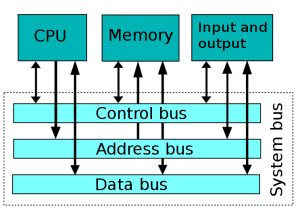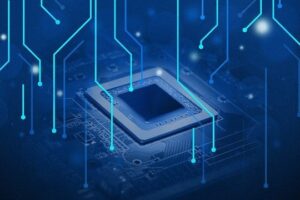Contents
What is Bus in Computer Systems: Understanding Its Role in Data Transfer
The bus in computer systems is a critical component that facilitates the transfer of data between different parts of a computer.
It acts as a communication pathway, allowing information to flow between the CPU, memory, input/output devices, and other hardware components. In this post, we will delve into the concept of the bus in computer systems, its types, and its significance in enabling efficient data transfer.

What is Bus in Computer System
The bus in computer systems is like a virtual highway that connects various components within a computer. It serves as a conduit through which data, instructions, and control signals travel.
The bus consists of a set of parallel wires, known as data lines, address lines, and control lines, which collectively enable communication between different hardware components.
There are several types of buses in a computer system, each serving a specific purpose. The most common types include the data bus, address bus, and control bus. Let’s take a closer look at each of them.
Data bus in computer
The data bus is responsible for carrying actual data between the CPU, memory, and other devices. It is a bidirectional bus, meaning that it can transfer data in both directions.
The width of the data bus determines the amount of data that can be transferred simultaneously.
For example, a 32-bit data bus can transfer 32 bits of data at a time, while a 64-bit data bus can transfer 64 bits.
Address bus in computer
The address bus, on the other hand, is responsible for transmitting memory addresses. When the CPU needs to read from or write to a specific memory location, it sends the address of that location on the address bus.
The width of the address bus determines the maximum memory capacity that can be accessed. For instance, a 16-bit address bus can access up to 64 kilobytes of memory, while a 32-bit address bus can access up to 4 gigabytes.
Control bus in computer
The control bus carries control signals that coordinate and regulate the activities of various components within the computer. These signals include read and write signals, interrupt signals, and clock signals.
The control bus ensures that data transfer and operations occur in a synchronized and orderly manner.
The bus in computer systems operates on a principle known as parallel communication. In parallel communication, multiple bits of data are transmitted simultaneously over separate lines or wires. This allows for faster data transfer compared to serial communication, where bits are sent one after another over a single line.
However, the increasing number of wires required for parallel communication can pose challenges in terms of complexity and cost.
Another important aspect of the bus in computer systems is bus width. Bus width refers to the number of lines or wires in a bus.
A wider bus can transfer more data in parallel, resulting in faster data transfer rates. Bus width is typically expressed in bits, and it is directly related to the overall performance of the computer system. A wider bus allows for greater data throughput and can handle more complex computational tasks.
In modern computer systems, buses have evolved to accommodate the increasing demands of data transfer.
Advanced buses, such as the Peripheral Component Interconnect (PCI) bus and the Universal Serial Bus (USB), provide faster data transfer rates and support a wide range of peripheral devices.
These buses have become standard interfaces for connecting devices like graphics cards, network adapters, and external storage devices to the computer.
The bus in computer systems plays a vital role in ensuring efficient and reliable data transfer. It enables the smooth operation of various components and allows them to work together seamlessly.
Without the bus, the CPU would have no way of communicating with memory, and input/output devices would not be able to exchange data with the rest of the system.
The bus in computer systems is not limited to personal computers alone. It is a fundamental concept that applies to other computing devices as well, including smartphones, tablets, and embedded systems.
These devices have their own buses that enable internal communication and data transfer.

Conclusion
the bus in computer systems serves as a crucial communication pathway, enabling the transfer of data between different hardware components. It consists of data, address, and control buses that work together to facilitate efficient data transfer and synchronization.
The bus’s width and type determine the amount of data that can be transferred and the specific functions it can perform. As computer systems continue to evolve, buses will play an increasingly important role in meeting the growing demands of data-intensive applications.
So, the next time you use a computer or any other electronic device, remember the bus in computer systems silently working behind the scenes to ensure smooth data transfer and efficient operation.

Friends, you have just read the post “What is Bus in Computer Systems: Understanding Its Role in Data Transfer” we hope you will like this post.
If yes then share it with your friends and keep visiting our website for more such posts.
If you interested to read about Astrology & Hindu Religion : Click here
……………………………
Technological Tips
Also Read : What is Deep Learning, Key Concepts & Important 5 Applications of Deep Learning
Also Read : Google Cloud AI: Shaping the Future of Intelligent Applications
Also Read Ethical hacking, difference between ethical hackers & malicious hackers, Is ethical hacking illegal?
Also Read : What is a Computer: How Computer Works- An Easy Explanation
Also Read : What is the Internet? How internet works, A Beginner’s Guide to Understanding the World Wide Web,
Health & Wellness
Also Read : Heavy Periods after Pregnancy: Causes, Symptoms, and Management are explained in detail
Also Read : Women’s Reproductive Health: Empowering Women through Knowledge and Care
Also Read : Fatty Lower Abdomen No More: Secrets to a Trim and Toned Waistline
Travel India
Also Read : Swaminarayan Akshardham Temple New Delhi- A Complete A to Z Tour Guide
Also Read : Exploring the Golden Triangle in India: A Journey Through History and Culture
Also Read : Best Travel Agencies in India: Exploring the Perfect Journeys : Top 5



